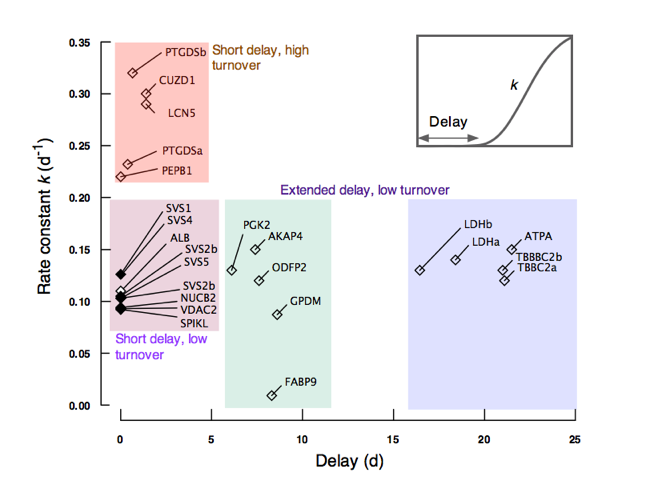Dynamic sperm labelling

Claydon AJ, Ramm SA, Pennington A, Hurst JL, Stockley P, Beynon R. (2012) Heterogenous turnover of sperm and seminal vesicle proteins in the mouse revealed by dynamic metabolic labeling. Mol Cell Proteomics .11(6):M111.014993. [PUBMED][PDF]
Abstract
Plasticity in ejaculate composition is predicted as an adaptive response to the evolutionary selective pressure of sperm competition. However, to respond rapidly to local competitive conditions requires dynamic modulation in the production of functionally relevant ejaculate proteins. Here we combine metabolic labeling of proteins with proteomics to explore the opportunity for such modulation within mammalian ejaculates. We assessed the rate at which proteins are synthesized and incorporated in the seminal vesicles of male house mice (Mus musculus domesticus), where major seminal fluid proteins with potential roles in sperm competition are produced. We compared rates of protein turnover in the seminal vesicle with those during spermatogenesis, the timing of which is well known in mice. The subjects were fed a diet containing deuterated valine ([(2)H(8)]valine) for up to 35 days, and the incorporation of dietary-labeled amino acid into seminal vesicle- or sperm-specific proteins was assessed by liquid chromatography-mass spectrometry of samples recovered from the seminal vesicle lumen and cauda epididymis, respectively. Analyses of epididymal contents were consistent with the known duration of spermatogenesis and sperm maturation in this species and in addition revealed evidence for a subset of epididymal proteins subject to rapid turnover. For seminal vesicle proteins, incorporation of the stable isotope was evident from day 2 of labeling, reaching a plateau of labeling by day 24. Hence, even in the absence of copulation, the seminal vesicle proteins and certain epididymal proteins demonstrate considerable turnover, a response that is consonant with the capacity to rapidly modulate protein production. These techniques can now be used to assess the extent of phenotypic plasticity in mammalian ejaculate production and allocation according to social and environmental cues of sperm competition.